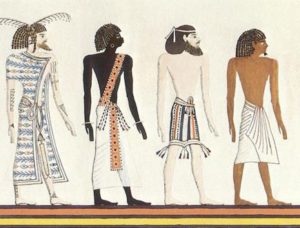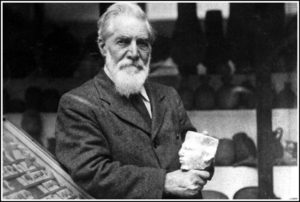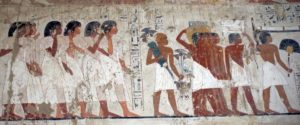The role of Ancient Egypt in theories of ‘race’.
Many academic disciplines in the nineteenth century were embedded within the racist ideologies of the societies and academies where they developed. This is true of the sciences and humanities, including Egyptology, which was directly linked to the study of ‘race’. However, before we go any further to exploring the relationship between racism and Egyptology, it is worth considering the following definitions.
- Race is a social construct that first appeared in the seventeenth century CE and it is biologically determined. It should not be confused with the term ethnicity.
- Ethnicity, which is defined as a category of people who identify with each other on the basis of shared ancestral, social, cultural or national experiences.

The drawing above appeared in the 1854 publication Types of Mankind by Josiah Clark Nott and George Robert Gliddon (1809-1857). It was taken from the Tomb of Seti I, where it was originally intended to show (from left to right) Libyan, Kushite, Asiatic and Egyptian/Kemite peoples. In their publications the pair copied the reliefs on Egyptian temples in order to claim that the ancient people were typically ‘Hellenic’ (of Greek descent), ‘Semitic’ and even ‘Jewish’.
Nott was an American physician and surgeon and he published on the theory of race. Gliddon was originally born in England but spent time in Alexandria, Egypt, which is possibly where he developed a fascination for the ancient culture. Both men were followers of the American physician Samuel George Morton, who advocated each ‘race’ of people had been created as a separate entity and were not from the same single source.
In 1844 Morton published a volume entitled Crania Aegyptiaca, for which he examined the remains of people from Kemet and concluded that they were not of African descent, but were somehow a “blend” of other races (p.4). A quick glance over the introduction instantly demonstrates how subjective and biased Morton was in his writing.
Racism and Egyptology

Sir William Matthew Flinders Petrie was appointed the first professor of Egyptology in the UK in 1892 at University College London (UCL). He was a prolific excavator of sites in Egypt, and wrote many publications on his work. Also at UCL during this period was Sir Francis Galton and Karl Pearson who were both pioneers of the eugenics movement. In fact Galton actually coined the term ‘eugenics’; a word taken from two ancient Greek words meaning ‘well/good’ and ‘group/kin’). His ideas are captured in a book entitled Hereditary Genius, published in 1869, where Galton wrote the following:
Let us do what we can to encourage the multiplication of the races best fitted to invent, and conform to, a high and generous civilisation, and not, out of mistaken instinct of giving support to the weak, prevent the incoming of strong and hearty individuals.
Galton, Pearson and Petrie worked closely together. Petrie provided the Anthropomorphic Laboratory at UCL with human skulls from Egypt for study. Thus, once again the ancient culture was used to illustrate theories of race. However, this time it was also directly influencing the newer field of Egyptology. Today these ‘theories of race’ are deemed to be racist, but Petrie fully embraced them in his work.

When I worked at the Petrie Museum as a research assistant, I was tasked with registering around 250 terracotta heads that had been collected by Petrie from the site of Memphis. Petrie became obsessed with identifying racial types, writing the following in 1909:
The discovery of portraits of the foreigners was not even thought of and only gradually was it realised that we had before us the figures of more than a dozen different races.
Such quotes show the extent to which Petrie was influenced by contemporary theories of race. If you are interested in further exploring the relationship between Petrie and Galton, it was the subject of a publication in 2013 by Debbie Challis entitled: The Archaeology of Race: The eugenic ideas of Francis Galton and Flinders Petrie. There are also a number of publications that were part of the Encounters with Ancient Egypt conference that critically explore how Egypt has been viewed in the past, and this includes a volume on Ancient Egypt in Africa.
How did the ancient people view themselves and others?

The ancient people of Kemet distinguished themselves in terms of their appearance and also their culture from their surrounding neighbours. It is worth noting that unlike the later European and North American theorists, these differences were not made solely on the grounds of physical appearance.
- Libyan people were typically distinguished by their light brown skin, shoulder lock of hair and their headdresses.
- Kushite people, from what is now Sudan, had black skin, short hair that was often coloured with henna and typically wore gold earrings, as a reference to their control of the gold mines.
- Asiatic people were the only non-Africans to be depicted, and came from the countries that would now be referred to as the Middle East. People from this region were generally shown with yellow skin (to identify them as being different to those who were African) and later in Roman period they were shown with pink coloured skin. They wore beards and were also depicted in clothes that were different to African peoples.
- Finally, Egyptian/Kemite people had a range of different skin colours from dark red to brown (see above) and were shown with many different types of clothing and hairstyles because artists depicted a greater range to represent their own people than for those who came from other cultures.
A final question
Given that the foundations of Egyptology are so closely connected to racist ideologies and theoretical frameworks, is there then, still evidence of this attitude within the discipline today? In my next few posts I will be highlighting how the remnants of past theories can permeate through to the present.

I heard that the most influential and widely cited racists and racialists like Morton, Coon, Elliot Smith, Sergi, Petrie, etc. considered dark skinned eastern Saharans to be the main founding populations of predynastic (upper) ancient Egypt. How true is that ?
If you read the early publication reports you find that some authors acknowledge an indigenous African presence, but like the Eugenicists, they categorise these people as part of a lower social class and are dismissive of their presence. Most of the British School of Archaeology and Egypt Exploration Fund reports are now published on-line. You have to read through them in their entirety because you will often find a comment on the subject in the form of a single sentence. But they are worth reading through.
Thanks, Ill try to look those up.
semite comes from kemite semite is a fake word derived in the 1800s
When did Egyptologists become experts on population genetics and bio-anthropology ? They’re area of expertise is more likely to be around religion, the rulers/imperial history, lifestyle and architecture. When it comes to genetics, Egyptologists are lay people.
Consult an expert like SOY Keita on the matter and they’ll say the AE were African.
Signs of the attitude still being present are in people’s resistance/downplaying of Egypt as an indigenous African civilisation, framing the wars between Egypt and Nubia as ‘race’ wars and denial of the African roots of Afro-Asiatic.
I agree entirely, and make this same point in another post: https://kemetexpert.com/category/dna/
Egyptology has its roots in genetics. Flinders Petrie and Galton themselves pioneers in eugenics.
Have you read civilization or barbarism by Cheikh Anta Diop?
Yes and I would recommend it to readers.
Have you seen Mathilda’s Anthropology Blog ? Its worth checking out. She has all sort of theories that i bet half of it she cant prove…Great article Btw
Thanks Stephine. Yes I have seen it, and agree it’s subjective. But she effectively admits that clearly in the ‘about this blog’ section.
Oh she does, because most of it is misinformation which is misleading anyone who have not looked at the solid evidence of Kemet being a strong African civilisation. But she claims it European. I have seen she used the National Geographic image of King Tut instead the bust which was made in his image by his fellow Kemetians who knew exactly how he looked. She is even claiming indigenous Africans on the Horn Ethiopians, Somalis, Tutsi etc to be Caucasians even more ridiculous but Black Caucasians. Then she says they are 40%-60% Caucasian hence some of their narrow skulls,and narrow facial features and tall structure even hair texture. I basically died when she said that. It is absolutely absurd. These indigenous africans are origin are african and not caucas regions. Are you aware of this theory?
I think the key here is to differentiate between opinion and empirically informed research. The next post I’m writing will be on perceptions and subjectivity.
Well, I have also read two books by a fellow called Erik von Danieken, a so-called Swiss palaeontologist. Infact , he refered to himself as a paleotheologist. He goes to great pains to prove that Africans could not have possibly build the pyramids. So the ramnants that you refer to are very much evident in modern day writtings & research on egyptology.
The two books are : chariots of fire & Return of the Gods